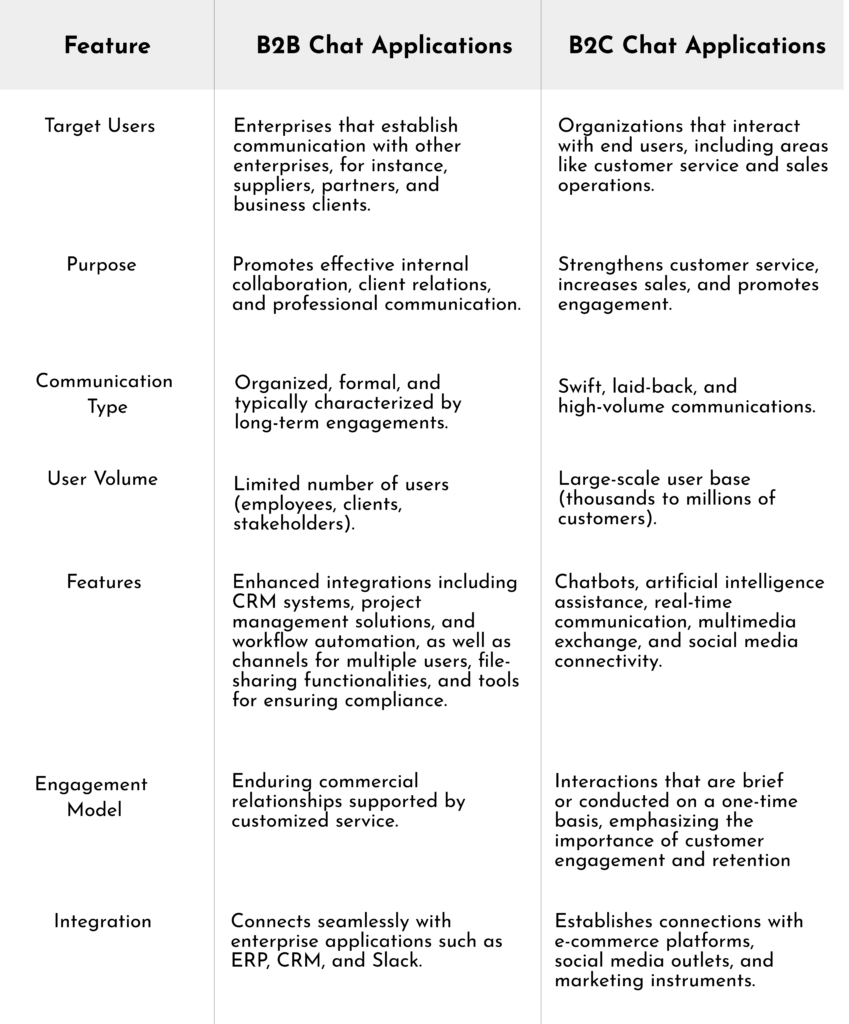Chat App: Build a Chat Application for either a B2B or B2C Platform
April 14, 2025 7:09 - no comments yetWebRTC PeerJS vs. SFU: Choosing the Best for Your Real Time Chat App
April 11, 2025 9:08 - no comments yetReal-time communication is a crucial aspect of modern applications, especially for video calls, voice chats, and instant messaging. Developers often face the challenge of selecting the best technology to power real-time interactions. Among the most popular choices are WebRTC with PeerJS and Selective Forwarding Units (SFU). But which is best for a real-time chat application?
This article explores WebRTC PeerJS and SFU architectures, comparing their strengths, weaknesses, and suitability for real-time chat applications.
Understanding WebRTC PeerJS
What is WebRTC?
Web Real-Time Communication ( WebRTC ) is an open-source project that enables peer-to-peer (P2P) audio, video, and data sharing between browsers and mobile applications without requiring intermediaries. It allows for low-latency communication and is supported by modern web browsers.
What is PeerJS?
PeerJS is a JavaScript library that simplifies WebRTC implementation by providing an abstraction layer. It eliminates the complexities involved in WebRTC's API and offers an easy-to-use interface for establishing P2P connections.
PeerJS offers a valuable opportunity to enhance digital communication while minimizing infrastructure costs. Although challenges remain, strategic implementation and local capacity development can help maximize the benefits of PeerJS-based solutions across sectors such as education, healthcare, and business.
How WebRTC PeerJS Works
WebRTC PeerJS operates in a decentralized manner. Each client (peer) directly connects with another client without passing through a central server, except for the signaling process. Signaling involves exchanging metadata to establish a connection, typically using a server but not for media transmission.
Advantages of WebRTC PeerJS:
- Low Latency: Direct P2P communication ensures minimal delays, making it suitable for one-on-one chats.
- Bandwidth Efficiency: Since there is no media relay server, bandwidth costs are minimal.
- Better Privacy: No intermediate servers store user data, enhancing security.
- Free & Open-Source: WebRTC and PeerJS are open-source, reducing licensing costs.
Disadvantages of WebRTC PeerJS:
- Scalability Issues: As the number of peers increases in a group chat, bandwidth usage grows exponentially since each peer needs to send media streams to multiple peers.
- NAT & Firewall Challenges: Establishing direct connections can be difficult when users are behind NAT (Network Address Translation) or restrictive firewalls.
- Quality Degradation in Large Groups: Peer-to-peer networks struggle with maintaining quality as more users join a session.
Understanding SFU
What is SFU?
An SFU is a media relay server that receives media streams from participants and selectively forwards them to other participants. Instead of peers sending media directly to all others, they send it to the SFU, which distributes it efficiently.
Video conferencing platforms like Zoom, Google Meet, and Microsoft Teams have revolutionized remote communication by enabling seamless virtual meetings, webinars, and collaborative workspaces. Similarly, WebRTC applications facilitate real-time live streaming, allowing users to engage in high-quality audio and video interactions without requiring additional plugins. Additionally, multi-party gaming and virtual events leverage advanced networking technologies to create immersive experiences where participants can interact, compete, and socialize in dynamic digital environments.
How SFU Works
- Each participant sends a single stream to the SFU.
- The SFU processes and distributes streams selectively based on network conditions, user preferences, and bandwidth availability.
- Participants receive only the streams necessary for their layout (eg, active speaker priority in video calls).
Advantages of SFU
- Scalability: SFU reduces bandwidth requirements, making it ideal for large group calls.
- Efficient Resource Utilization: Participants send only one upload stream instead of multiple.
- Better Quality Control: SFU can adjust video resolution and bitrate dynamically, optimizing performance.
- Cross-Network Compatibility: SFUs mitigate NAT traversal issues, improving connectivity across different network environments.
Disadvantages of SFU
- Increased Server Costs: Unlike P2P, SFU requires infrastructure and hosting, increasing operational expenses.
- Slightly Higher Latency: Routing through a media server introduces minimal additional latency.
- Implementation Complexity: Deploying an SFU requires more configuration and development effort than P2P WebRTC.
Comparison: WebRTC PeerJS vs. SFU for Real-Time Chat Applications
Which One Should You Choose?
The choice between WebRTC PeerJS and SFU depends on the type of real-time chat application you are building. Here's a breakdown based on use cases:
When to Use WebRTC PeerJS
- One-on-One Calls: If your application primarily involves direct communication between two users, WebRTC PeerJS is the best option due to its low latency and minimal server costs.
- Small Group Calls: PeerJS can handle small group chats (up to 4 users), provided bandwidth is not a major concern.
- Privacy-Focused Apps: Since there's no central server handling media, PeerJS is suitable for secure, encrypted communications.
- Cost-Sensitive Applications: PeerJS eliminates server costs apart from signaling, making it a budget-friendly solution.
When to Use SFU
- Large Group Calls: If your application supports meetings, webinars, or classrooms with multiple participants, SFU is necessary for efficient bandwidth management.
- Business & Enterprise Solutions: SFUs ensure better quality control, adaptive streaming, and reliability, which are critical for professional settings.
- Public-Facing Applications: If users connect from diverse networks (eg, corporate, mobile, or home networks), SFU mitigates NAT/firewall challenges.
- Feature-Rich Platforms: If you need dynamic layouts, active speaker detection, and real-time video quality adjustments, SFU is the superior choice.
Hybrid Approach: Combining WebRTC PeerJS with SFU
Some applications use a hybrid model where WebRTC PeerJS is used for direct calls, while SFU is employed when the number of participants increases. This approach provides the best of both worlds, reducing costs for small calls while ensuring scalability for larger meetings.
Example:
- P2P Mode: Use WebRTC PeerJS for one-on-one and small group calls (2–4 participants).
- Switch to SFU: When a session exceeds 4 participants, transition to an SFU to optimize bandwidth and maintain quality.
Conclusion
Both WebRTC PeerJS and SFU offer real-time communication capabilities, but their suitability depends on your application's needs. If you are building a small-scale, peer-to-peer chat app, WebRTC with PeerJS is an excellent choice due to its low latency, cost efficiency, and simplicity. However, if you require a scalable solution for large group calls, an SFU-based architecture is the way to go, as it optimizes bandwidth and server performance.
Ultimately, the decision comes down to your target audience, expected user base, and available infrastructure. If scalability is crucial, SFU is the superior choice. If cost-efficiency and simplicity matter more, WebRTC PeerJS is the better option.
Would you like help with implementing a specific solution for your real-time chat application? Then Do Contact us , will help to build the chat application according to your needs .
How To Add Free Video and Audio Call APIs in the iOS and Android app?
April 8, 2025 6:59 - no comments yetIn the present digital era, Free Video and Audio Call applications are vital tools for enabling real-time communication. If you are working on a mobile app and intend to add free video and audio calling features, suitable API integrations can transform your app into a fully functional video-calling application for iPhone, iPad, or both. Therefore, WebRTC is a key technology in the creation of effective and seamless video-calling applications.
This blog serves as a resource to navigate the process of integrating video and audio call APIs, constructing a real-time communication application, and delving into advantageous features like call history tracking, in addition to supporting both single and group calls.
What is Webrtc?
WebRTC, which stands for Web Real-Time Communication, is an open-source standard that facilitates real-time communication (RTC) between web browsers, mobile applications, and various devices. It allows users to exchange audio, video, and data directly without the involvement of an intermediary server, making it particularly advantageous for applications such as video calling, voice chatting, file sharing, and live streaming.
How Webrtc Works?
WebRTC facilitates real-time communication by allowing devices to connect directly with one another. It enables the exchange of audio, video, and data without intermediaries.
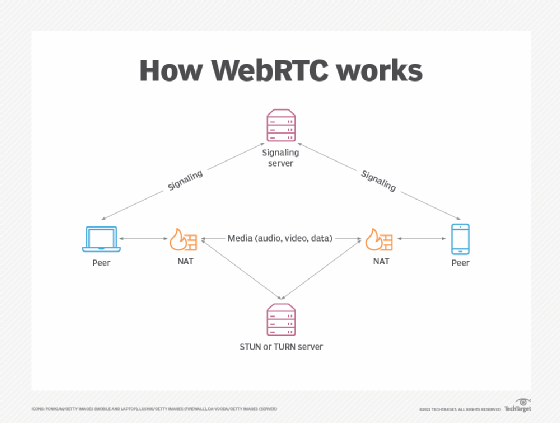
This diagram illustrates the establishment of a connection for audio and video calls via a peer-to-peer network.
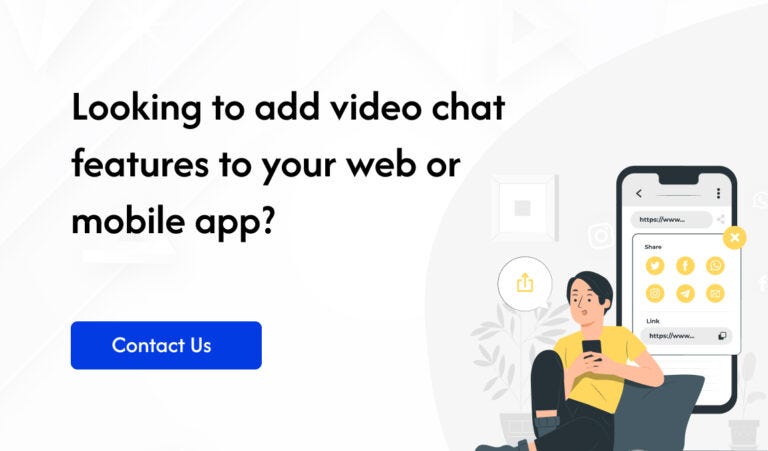
How to Connect Api?
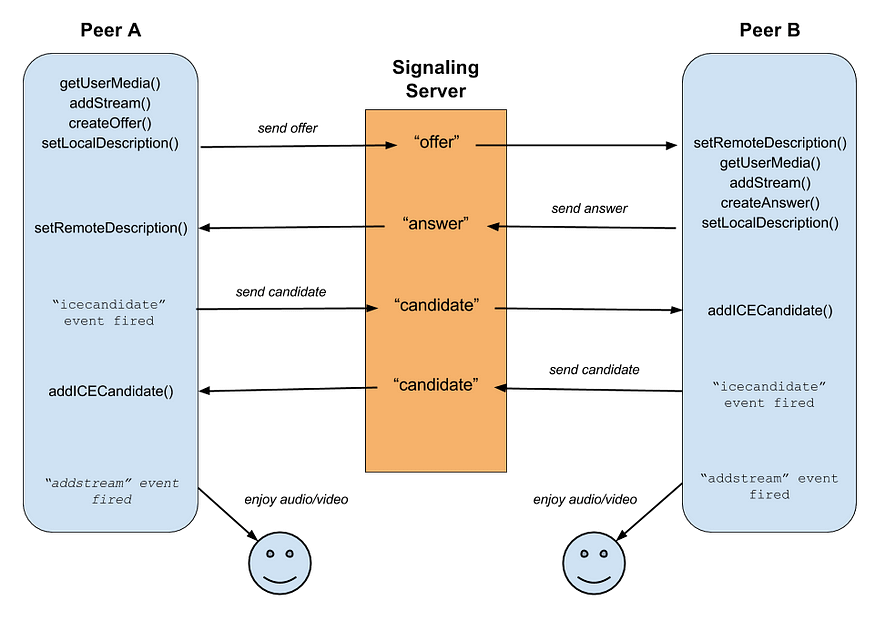
What is P2P Communication?
The Peer-to-Peer (P2P) connectivity model is a form of network communication in which each participant has equal capabilities, enabling any individual to start a communication session. This differs from traditional client-server models, where communication is typically governed by a central server that manages requests and responses. P2P networks promote direct interactions among peers. In the context of WebRTC, P2P connectivity is crucial as it allows for immediate, real-time communication without routing data through an intermediary server, which helps to decrease latency and bolster privacy and scalability.
By employing a peer-to-peer model, WebRTC establishes connections between web clients, which enables the efficient exchange of media and data streams. The technology incorporates JavaScript APIs to mitigate the complexities associated with real-time media exchange, thus rendering it user-friendly for developers lacking in-depth knowledge of communication protocols or real-time system architecture.
The architecture of How Our API works in the Backend for Free Video and Audio Call
PeerJS encapsulates the WebRTC functionality of the browser, offering a more straightforward and user-friendly API for establishing peer-to-peer connections. An accompanying image is provided for further clarification.

Here is step-by-step explanation:
1) When users initiate a call, the system will first send a request to the STUN server to obtain the public identity, similar to the peer user data from the sender’s side. Following this, it will make a request to the backend to establish the call. The server will then create a socket room and emit the relevant data to the designated room.
2)The backend will inform the corresponding receiver user by transmitting sender data through a peer data connection. Subsequently, the receiver user will determine whether to accept or decline the call.
3) If the user picks up the call then, the system will send a request to the Stun server to obtain the public identity, similar to the peer User data. Subsequently, it will notify the backend of its readiness to join the call. The server will then supply the receiver data (Peer data) to the socket room.
4) On the Sender side, the User will get the data( Peer data) of all receivers.
5) A connection between peers is formed on each side, allowing for the exchange of streams in real-time as both parties are in the call.
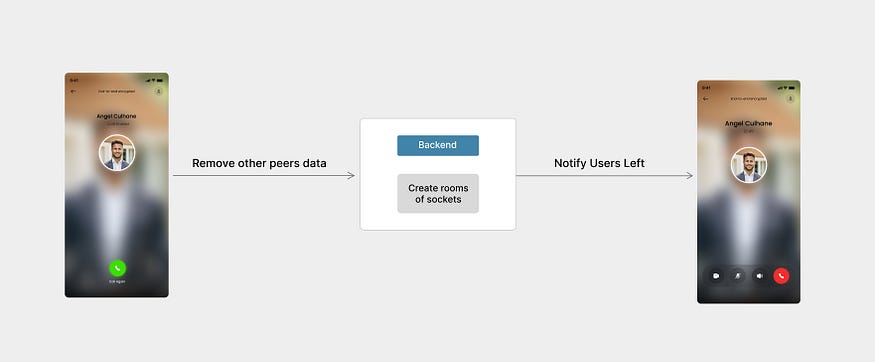
6) If Declined on the receiver side, the server will be instructed not to join the call. If there are already participants in the call, they will be notified that the new user has not joined, ensuring that the ongoing call remains unaffected. If only one user is present in the room, likely the host, the sender will be informed that the call has been declined, and subsequently, the room will be closed.
7) If an ongoing call, Initially it will eliminate all peer user data from its local storage. Subsequently, it will inform the backend of the call decline, prompting the backend to notify the other participants in the ongoing call.
8) Ongoing calls with other users, another user will eliminate the peer data associated with that particular user, which includes terminating the stream and disconnecting the peer connection for that specific user.
Note: An explanation has been provided regarding the overall structure of the WebRTC PeerJS connection, including insights into its functionality within the backend of your application
What functions you can implement in your app or website
1) Video and Audio Conferencing
Users can make video and audio calls in real time. You can also set up group conferences by connecting multiple peers.
2) Live Streaming
Host live events or webinars and stream them straight to your connected peers. You can send out a single broadcast to reach multiple viewers at the same time.
3) Social Media Features
Audio and video chat rooms that operate on a peer-to-peer basis. Real-time broadcasting with minimal delay.
Develop An Audio and Video Calling Application with Primocys
If you want to build a top-notch video-calling app, Primocys can help you make the right choice. We are a leading web and Mobile App Development Company with 7 years of Experience and expert developers at PRIMOCYS!
If you too want to build an app and are unsure of how to begin the process, schedule your appointment or book your consultation today with primocys expert, our email for all your queries is [email protected] Or Let’s connect to chat.
Conclusion
This blog shows the architecture of how audio and video calls work. You can explore our demo product whoxachat app where the APIs of video and audio calls are implemented and can check the flow of it.
Here you can also check the whoxachat web version too, for any details you can contact us at [email protected]
Instagram Clone App: Build Your Own Photo-Sharing Social Platform
April 4, 2025 10:21 - no comments yetIn the constantly changing digital landscape, social media platforms are transforming the way people connect, share, and interact. Instagram, in particular, stands out as one of the most popular and influential photo-sharing applications in the world. Entrepreneurs and businesses that want to create their own social media platforms often look for Instagram clone apps, which provide similar features along with customized functionalities tailored to their brand. If you are searching for the best Instagram clone app developer in New York, Primocys is your top choice.
Why Choose Primocys for Your Instagram Clone App Development?
Primocys is a leading app development company specializing in photo-sharing apps like Instagram. With extensive expertise in building Instagram clone scripts, our team ensures seamless functionality, an intuitive user interface, and scalability to support millions of users. Here’s why Primocys is the preferred choice:
1. Custom-Built Instagram Clone Apps
Primocys provides custom Instagram clone app iOS and Instagram clone app Android solutions that meet unique business requirements. Our apps are tailored with robust features such as:
- User Profiles & Authentication — Secure registration and login options.
- Photo & Video Sharing — High-quality uploads with filters and editing tools.
- Stories & Reels Integration — Short video content for engaging audiences.
- Live Streaming — Real-time interactions with followers allow users to broadcast live videos in real-time with their followers.
- Messaging & Notifications — Instant communication with push alerts.
- Monetization Options — In-app purchases, ads, and premium subscriptions.
2. High-Performance and Scalable Solutions
Our Instagram clone script is built for optimal performance and scalability. Whether you’re developing a startup-level app or a comprehensive social media platform, Primocys ensures your application can efficiently handle increasing user demands.
3. Cross-Platform Compatibility
Primocys develops Instagram clone apps for both iOS and Android, ensuring smooth operation across multiple devices. Our cross-platform solutions reduce development costs while maintaining excellent performance and usability.
4. User-Centric UI/UX Design
A user-friendly and visually appealing interface is essential for social media apps. Our skilled designers develop intuitive layouts and seamless navigation, ensuring an exceptional user experience.
5. Advanced Security Features
Ensuring security is a top priority in developing social media apps. Our Instagram clone applications come equipped with:
- Data encryption and secure login authentication.
- Robust backend infrastructure to prevent hacking and unauthorized access.
- GDPR and privacy compliance to protect user data.
Features of Primocys’ Instagram Clone Apps
Whether you are launching a niche-specific social media platform or a full-scale photo sharing app like Instagram, Primocys integrates top-tier features to keep users engaged.
- Profile Management: Users can create, edit, and personalize their profiles with bios, links, and profile pictures.
- Feed & Timeline: Users can scroll through posts from people they follow, with AI-driven recommendations.
- Photo & Video Uploads: Advanced editing tools, filters, and cropping options enhance user content.
- Likes, Comments & Shares: Encouraging engagement with interactive features.
- Stories & Live Streaming: Captivating real-time updates and interactions.
- Explore & Search Functionality: Users can find trending content, hashtags, and popular profiles.
- Post & Reel: Users can publish posts or reels to their feed, and followers can participate by liking or leaving comments on these posts or reels.
- Push Notifications: Keeps users updated on interactions, messages, and new posts.
- Monetization & Ads Integration: Businesses can run ads, subscriptions, and premium features.
- Managing Profile Settings: Update your profile details, preferences, and security settings to personalize your Sellapy experience.
Why Businesses Should Invest in an Instagram Clone App
Investing in a photo-sharing app similar to Instagram presents a lucrative opportunity due to the immense demand for social networking platforms. Here are several reasons why businesses should consider launching their own photo-sharing apps like Instagram:
- Growing Market: The social media industry is expected to reach billions of users worldwide.
- Monetization Opportunities: Multiple revenue streams, including in-app purchases, advertisements, and premium subscriptions.
- Brand Recognition: Establish a unique digital identity and engage with a global audience.
- Community Building: Create a niche-specific social platform catering to specific interests or demographics.
Get Your Instagram Clone App Developed by Primocys
If you’re ready to launch your Instagram clone app for iOS or Android, Primocys is here to bring your vision to life. Our team of skilled developers and designers is dedicated to delivering exceptional solutions using the latest technology.
With our expertise in developing Instagram clone scripts and social media applications, we guarantee:
- On-time project delivery.
- Customization to meet unique business goals.
- 24/7 support and maintenance.
- Seamless user experience and robust performance.
Contact Primocys today to create your ideal social media app and make an impact in the digital world!
Build your Own Secure Chat App with Audio/Video calls for any business
April 1, 2025 7:27 - no comments yetIn today's fast-paced digital world, communication has evolved significantly. Businesses increasingly rely on secure messaging platforms to enhance collaboration and protect sensitive data. Whether you are running a small business or a large enterprise, building your own secure chat app with audio/video calls can provide a robust communication channel tailored to your specific needs.
Why You Need a Secure Chat App for Your Business
Businesses require instant messaging solutions that offer privacy, security, and seamless communication. Traditional messaging apps may not provide the level of encryption and data protection required for confidential business conversations. A private messaging app tailored to your business can ensure that all communications remain secure, reducing the risk of data breaches and cyber threats.
- Data Protection: Safeguard sensitive business information from breaches.
- Compliance: Meet regulatory requirements for secure communication.
- Productivity: Streamlined team collaboration through group chat apps and AI-driven chat features.
- Seamless Communication: High-quality video call and chat app features for global teams.
- Brand Customization: Businesses can build a white-label messaging app tailored to their needs.
Key Features of a Secure Chat App
Developing a secure chat platform requires integrating multiple advanced features that ensure seamless and protected communication. Below are essential components every encrypted messaging app should have:
1. End-to-end encryption for Ultimate Security
A secure chat app should prioritize end-to-end encryption to prevent unauthorized access to messages and calls. This ensures that only the sender and recipient can access the conversation, enhancing confidentiality.
2. Instant Messaging with Real-Time Synchronization
A messaging app should support real-time synchronization across devices to allow seamless communication without delays. This feature is crucial for teams that require constant interaction.
3. High-Quality Audio and Video Calls
An effective video call and chat app must support high-quality audio and video communication. Businesses need crystal-clear communication channels for virtual meetings, training sessions, and remote collaborations.
4. Voice Note Messenger for Quick Communication
A voice note messenger feature is essential for businesses that prefer voice messages over text. This is particularly useful in industries where typing may be inconvenient, such as logistics and healthcare.
5. Group Chat for Team Collaboration
A group chat app should allow teams to create groups, assign roles, and manage members effectively. This feature is critical for fostering teamwork and streamlining communication.
6. AI Chat Features for Smart Conversations
Integrating AI chat features enhances user experience by enabling chatbots, automated replies, and intelligent suggestions. Businesses can use AI-powered assistance for customer support and workflow automation.
7. File Sharing Messenger for Seamless Document Exchange
A file-sharing messenger should enable businesses to send documents, images, videos, and other files securely. This feature is crucial for smooth business operations and project management.
8. Download Chat App
Provide cross-platform compatibility by offering mobile, desktop, and web versions of your messaging app.
To have a look at the demo of Android or iOS, connect to us on email and WhatsApp.
9. Secure Private Chat App
A private messaging app should offer features like self-destructing messages, two-factor authentication, and password-protected chats.
10. Chat App for Businesses
A business-specific secure chat platform should integrate with CRM software, task management tools, and cloud storage for seamless workflow.
Steps to Build Your Secure Chat App
Step 1: Define Your Business Requirements
Identify the core functionalities your business requires in a private messaging app. Consider factors such as security level, user interface, scalability, and integration with existing business tools.
Step 2: Choose the Right Technology Stack
Selecting the appropriate technology stack is crucial for ensuring the reliability and performance of your secure chat platform. Consider using:
- Frontend: React Native, Flutter
- Backend: Node.js, Django, Firebase
- Database: PostgreSQL, MongoDB
- Encryption Protocols: AES-256, RSA, TLS/SSL
Step 3: Implement Secure Authentication
Ensure that your encrypted messaging app includes multi-factor authentication (MFA), biometric authentication, and OAuth-based login options to protect user accounts.
Step 4: Develop the Messaging and Calling Features
Work on integrating real-time chat, video call and chat app functionality, and voice note messenger features. Use WebRTC for audio and video calls to provide high-quality communication.
Step 5: Integrate AI Chat Features
AI-driven chatbots and automated responses can enhance user experience and provide smart business solutions. This feature is essential for improving productivity and customer engagement.
Step 6: Ensure Compliance and Data Privacy
Adhere to industry regulations such as GDPR, HIPAA, and SOC 2 compliance to ensure data privacy. Implement role-based access controls and activity logging for better security.
Step 7: Test and Optimize
Conduct extensive testing to identify bugs and performance issues. Optimize your app for speed, security, and seamless user experience.
Which industries use our video call app?
Various industries rely on video call apps for seamless communication. Healthcare uses them for telemedicine, while education enables virtual learning. Businesses conduct remote meetings, customer support, and training. Other industries include legal, finance, real estate, and entertainment for consultations and collaborations.
Deploying and Maintaining Your Chat App
Once the app is built, deploy it on platforms like AWS, Google Cloud, or Azure for scalability and performance optimization. Regular updates and security patches are necessary to keep your secure chat app efficient and resilient against threats.
Conclusion
Building a secure private chat app with audio/video calls is crucial for businesses prioritizing data security, team collaboration, and seamless communication. By integrating advanced AI chat features, end-to-end encryption, and secure file-sharing, businesses can ensure privacy while enhancing productivity. Whether you're developing an instant messaging app for internal teams or customers, following the steps in this guide will help you create a robust, feature-rich secure chat platform.
To look at the Android or iOS demo, connect to us on email and WhatsApp .
Want to read more?
How To Add Free Video and Audio Call APIs in the iOS and Android app?
Chat App: Build a Chat Application for either a B2B or B2C Platform
How to Build a Real-time Chat App using Flutter, Socket.io & NodeJS?

